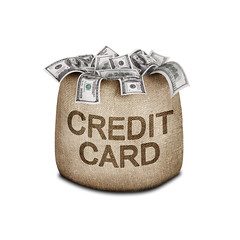It’s easy to make mistakes when using your credit card. The problem is that there’s no practice here, no trial periods; the consequence can be quite harmful and expensive. To help you avoid these problems, here are the top 10 worst credit card mistakes you should avoid.
Mistake #1: Not paying your bills on time
Know what the worst mistake to make on your credit card? Not paying your bills on time. This triggers three unwanted effects: late payment fees, increased interest rates and a reduced credit rating. One late payment alone can lower your credit rating and increase your debt considerably.
Mistake #2: Going after introductory rates
That zero per cent interest rate teaser rate may look awfully tempting, but before you even consider applying for the credit card or getting a balance transfer, make sure you know what its regular rate would be. This, after all, is what you have to live with when the honeymoon is over. They don’t call it teaser rate for nothing.
Mistake #3: Getting cash advances
Even the most benign, low-rate credit card can turn into a monstrosity once you get a cash advance, which is why you should resort to it only during emergencies. Here’s why: cash advances ask for an upfront charge and impose mind-bogglingly high interest rates. Worst of all, there’s no grace period for it—the cash advance starts charging once you get hold of the money. Our tip: look into other means to get cash before considering a cash advance.
Mistake #4: Spending to get rewards
Here’s something you probably already know: those rewards that your credit card gives you aren’t free. To get more of these points or frequent flyer miles, you have to spend more. However, you shouldn’t spend just to get rewards because you’ll only end up spending more than you should.
Mistake #5: Using up all your credit
Just because you have a certain amount of credit, it doesn’t mean you should use it all. You’ll have to consider the ratio of your total available credit because it has a significant effect on your credit score. Besides, using up all your credit means you also have to deal with higher interest rates and an over-limit fee.
Mistake #6: Making only the minimum payment
It doesn’t matter that you get the credit card with the lowest interest rates. If you make only the minimum payment every month, you’ll be in debt much longer and spend more overall. How long? If you had a balance of $15,000 with a rate of 13.25 per cent p.a., but paid only $50 per month, it would take you 17 years and three months to pay the debt fully, and spend $1,988 per year on interest.
Mistake #7: Getting too many credit cards
Having too many cards (i.e. more than two) is asking for trouble. For starters, you need to remember the monthly payments and balances of each one. And unless you’re unbelievably rich, you probably won’t be paying their balances in full, which means the interest rates will have you paying more than you should. If you skip a payment, expect your debt to snowball. Even if you’re able to keep all at zero balance, you’ll have to deal with annual fees for each.
Mistake #8: Disregarding your statement
Monthly statements have several purposes: to inform you about your due date, show how much you need to pay, and give you a breakdown of your card’s expenditures. You may already know your due date by heart, but you still need to check your statements for mistakes or—more importantly—fraudulent purchases.
Mistake #9: Buying things you don’t need
The convenience of using credit cards can sometimes lead us to spend for things we don’t need, and this leads us to useless debt. If you’re tempted to buy something that’s not in your budget, consider first if you need it, and then wait for some time (at least a week) before you purchase it. If it’s just the itch, then the urge could be gone by then. If you still really need it, then by all means.
Mistake #10: Not reading the fine print
The fine print will tell you a lot of useful things, like how much is charged for balance transfers, how long the introductory rate lasts and any other limits. Make sure you read and understand all these details before signing anything, or else you’ll be stuck with an overcharging card you don’t want.

